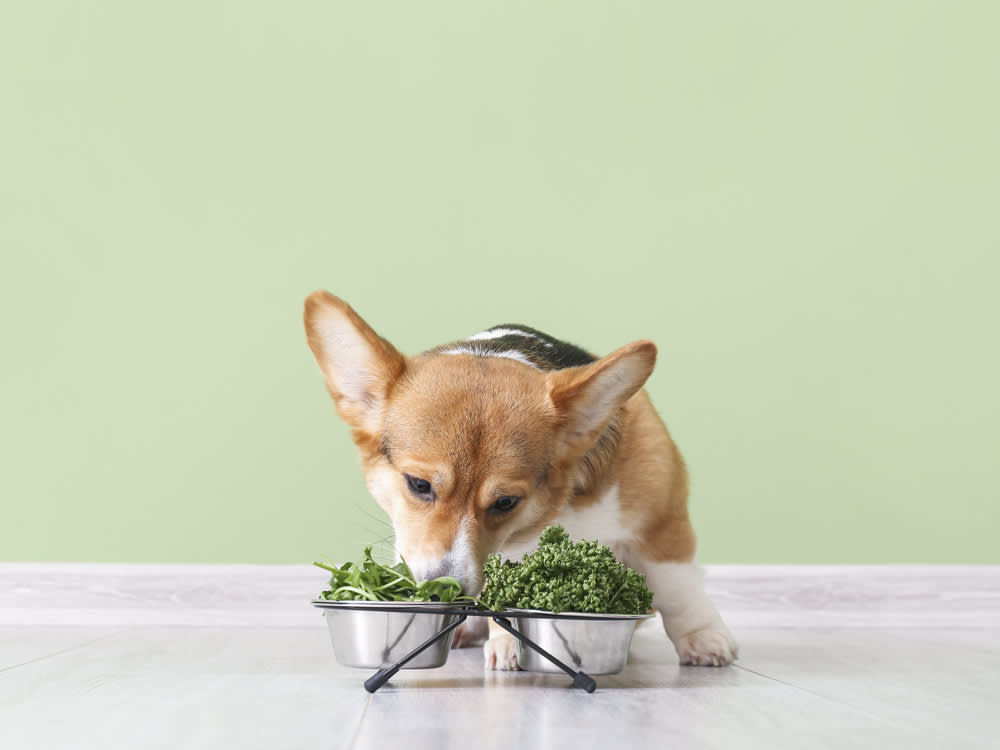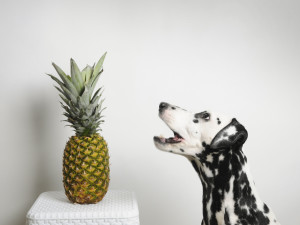Can Dogs Eat Kale?
Yep — this superfood is good for your dog in small amounts.

Share Article
Kale has long been touted as a superfood perfect to toss into your smoothie and sneak in an extra boost in nutrition (without the incredibly rough texture). Turns out this star on the food pyramid is also a nutritional boon to your dog’s health.
In general, leafy green vegetables pack a ton of vitamins, minerals, carotenoids, and flavonoids. Many fall into the cruciferous family, which includes kale, spinach, chard, mustard greens, beet greens, collards, dandelion greens, broccoli, cauliflower, cabbage, bok choy, and brussels sprouts. If you’re looking to add more leafy greens to your dog’s diet, kale is a good place to start — as long as you feed it to your pup in moderation. Here’s how.

littleKin™ is Kinship’s home just for puppy and kitten parents. Bop over to check out expert advice, new pet tools, and special deals—all curated for your newest family member.
opens in a new tabNutrition facts: Kale for dogs
Is kale good for dogs?
A rich source of vitamins A, B6, C, and E, as well as folate and manganese, kale also provides thiamin, riboflavin, pantothenic acid, and several minerals such as iron, potassium, and phosphorus. Additionally, kale is a great source of two main antioxidants, lutein and zeaxanthin, which can potentially protect your pup from cancer.
Adding small amounts of kale to your dog’s diet can support vision and colon health and liver detoxification; it can also help stave off infections. And, if your dog needs to drop a few poundsopens in a new tab, lightly cooked kale can be added to their meal as a topper, increasing their satisfaction without adding too many calories.
Can dogs eat kale?
Kale is a great addition to your dog’s diet, as long as you feed it to them in small amounts — too much can cause gastric issues, kidney or bladder stones, or thyroid disfunction, according to the American Kennel Clubopens in a new tab (AKC). Here’s how to safely feed it to your pup:
Steam or blanch it: Boiling diminishes kale’s nutrient profile, so it’s best to lightly steam or blanch it. To blanch kale (and other vegetables), quickly submerge it first in boiling water and then in very cold ice water. Blanching is not only a good way to prepare leafy vegetables, it also cleans off any dirt that may be clinging to the leaves and helps retain more of the vegetable’s vitamins and flavor.
Sauté the stems: Most recipes intended for human consumption advise you to strip the leaves off their woody stems or ribs before cooking. But when using it for dogs, you can include the ribs by chopping or pulverizing them and then lightly sautéing or roasting them. You can also freeze extra stems to add to a future meal for your dog. (Do not feed the stems to your dog if they are prone to kidney and bladder stones, per the AKC.)
Massage the leaves: First, finely slice or chop the leaves. Then, massage them by hand for a couple of minutes, which will make them tender enough to eat without cooking. Still, you may want to lightly sauté them before serving to your pup.
Puree the leaves and stems: You can also puree steamed or blanched kale — leaves and ribs included — in a food processor or Vitamix-type blender. Add a splash of the steaming or blanching water to make pureeing easier.
Add it to a smoothie: Whip up a dog-friendly, superfood smoothie using kale, blueberriesopens in a new tab, bananaopens in a new tab, yogurt, chia seedsopens in a new tab, and other fruits or vegetables. Add a few spoonfuls to your dog’s food as a meal topper or sneak it into a stuffed Kong and then freeze the Kongopens in a new tab. You could also freeze the smoothie in silicone forms or ice cube trays to make refreshing, lickable summer treats.
Make kale chips: Another way you can share this nutritious leafy vegetable with your dog is to make a batch of kale chips that you both can enjoy.
Is kale completely safe for dogs?
There are three main types of kale. The sweetest, Lacinato (also called dinosaur or Tuscan kale) is dark green with long, flat leaves, and it’s the easiest to use. Then there’s curly kale, which — you guessed it — has very curly, green leaves that are somewhat bitter. Finally, the mildest of the three types is a Russian variety with lobed leaves and magenta stems.
Other foods that are healthy for dogs
Green beans: Not only are green beans safe for dogs, they’re also full of health benefitsopens in a new tab.
Celery: Celery, nature’s perfect spoon, can provide fiber and hydrationopens in a new tab for your dog.
Sweet potato: Add sweet potatoes to the list of healthy human superfoodsopens in a new tab your pup can eat, too.
Other foods that are not healthy for dogs
Cashews: Though they may not be toxic, cashews are high in fatopens in a new tab, and so they’re not the healthiest snack for your dog.
Bread: This carb-heavy treatopens in a new tab should be shared only in moderation and only after you’ve checked the ingredients first.
Potatoes: Carb-heavy potatoesopens in a new tab are just OK for your pup, and raw potatoes should be avoided entirely.
The bottom line: Can dogs eat kale?
Yes, dogs can eat kale in moderation. Like all treats, kale should be supplementary to a complete and balanced dog food diet.
FAQs (People also ask):
Is it OK to give dogs kale?
Yes, it is okay to give dogs leafy greens like kale in moderation.
Is kale good for dogs?
Kale is a rich source of vitamins A, B6, C, and E, as well as antioxidants like lutein and zeaxanthin that can potentially protect your dog from cancer.
Can dogs eat kale stems?
Yes, your pup can eat kale stems. Try chopping or pulverizing them and then lightly sautéing or roasting them before giving them to your dog.
How much kale can dogs eat?
You should only give small amounts of kale to your dog. Too much could potentially cause gastric issues, kidney or bladder stones, or thyroid disfunction.
References

Claudia Kawczynska
Claudia Kawczynska was co-founder and editor-in-chief of The Bark for 20 years. She also edited the best-selling anthology Dog Is My Co-Pilot.
Related articles
![Various Veggie Chips in a Ceramic Blue Bowl]() opens in a new tab
opens in a new tabCan Dogs Eat Sweet Potatoes?
Add it to the list of healthy human superfoods pups can eat, too.
![Beagle puppy dog holding a peeled carrot in its front paws sitting in the grass]() opens in a new tab
opens in a new tabCan Dogs Eat Carrots?
Yep—this crunchy, sweet vegetable is a great addition to your dog’s diet.
![Ridgeback puppy eating an apple from a low-hanging tree]() opens in a new tab
opens in a new tabCan Dogs Eat Apples?
Here’s why this fiber-filled fruit is a healthy treat for your dog.
- opens in a new tab
Can Dogs Eat Pineapple?
Pineapple is a healthy, sweet treat for dogs—as long as you feed it to your pup in moderation.



